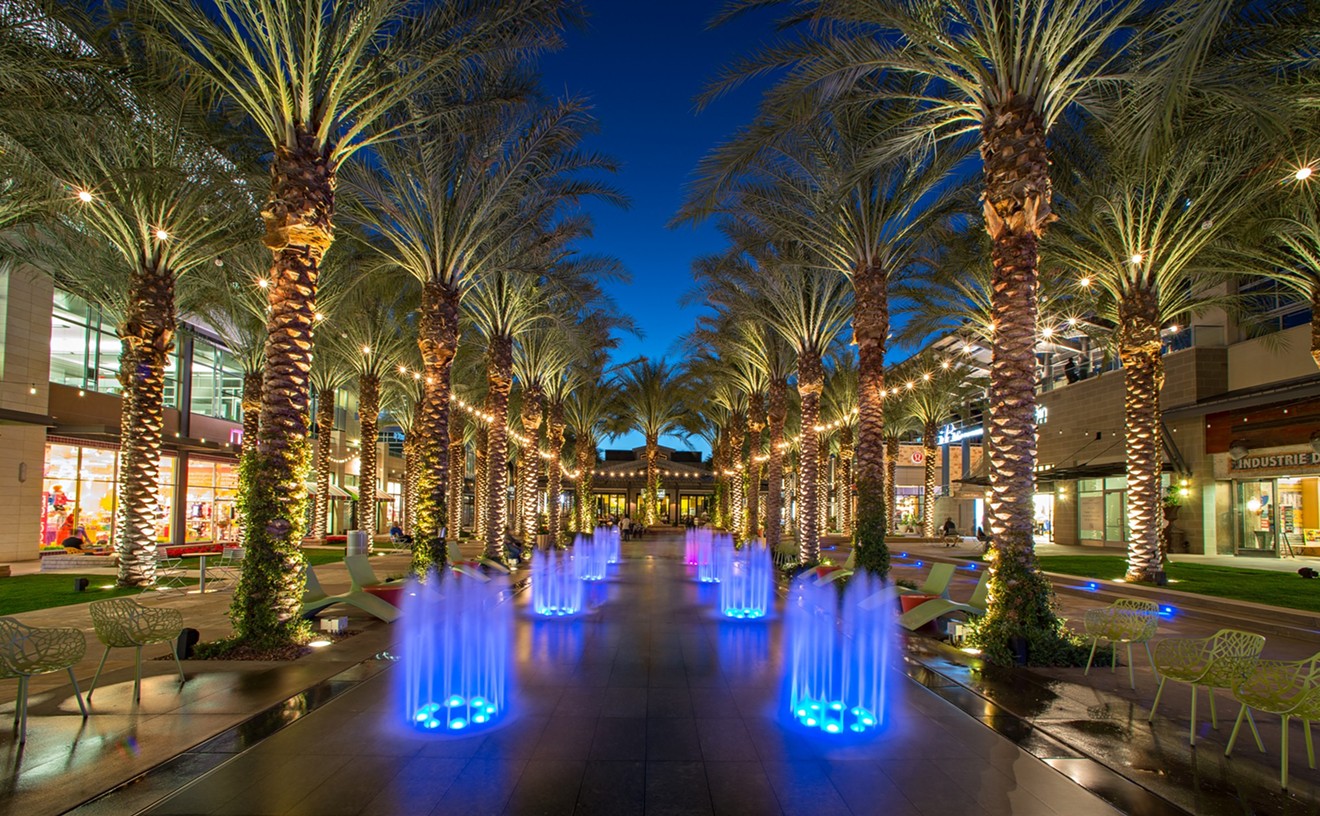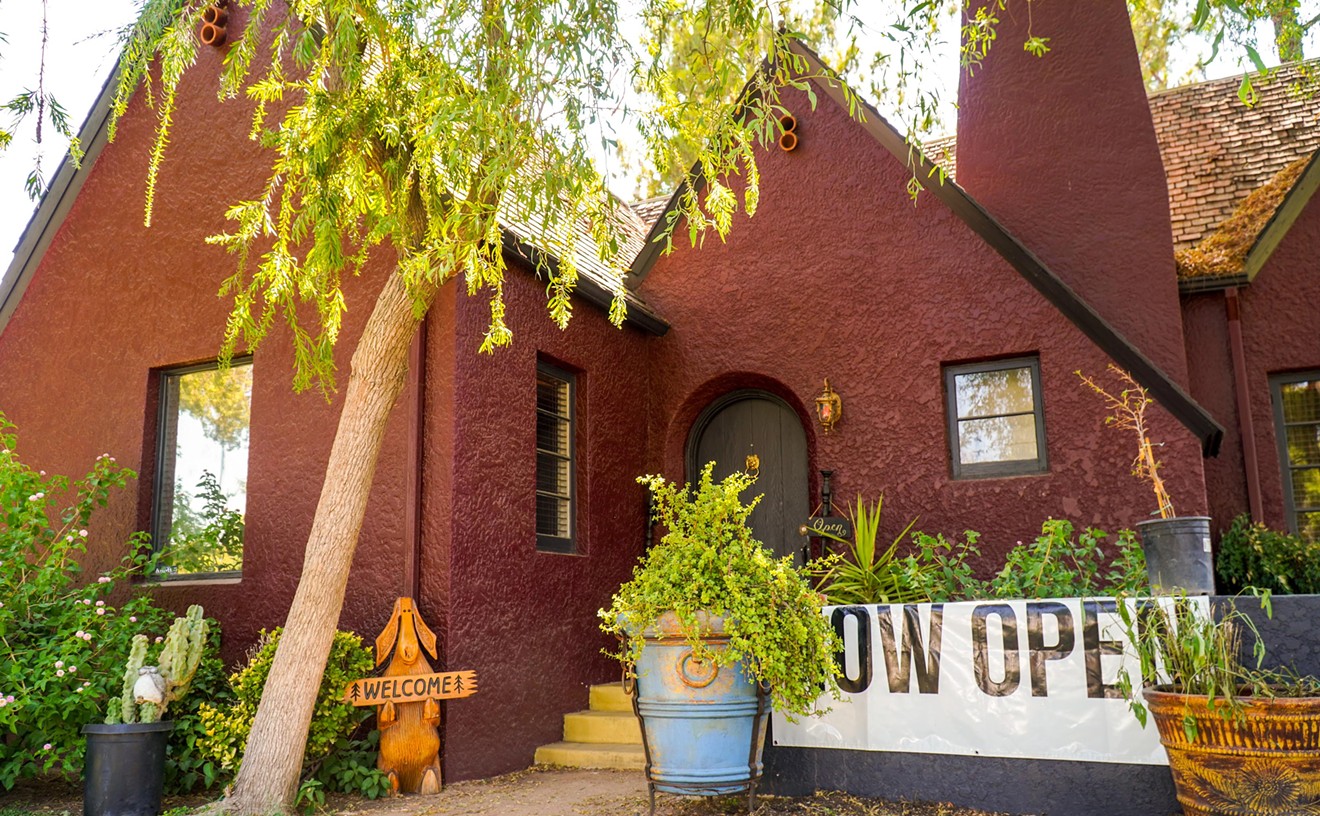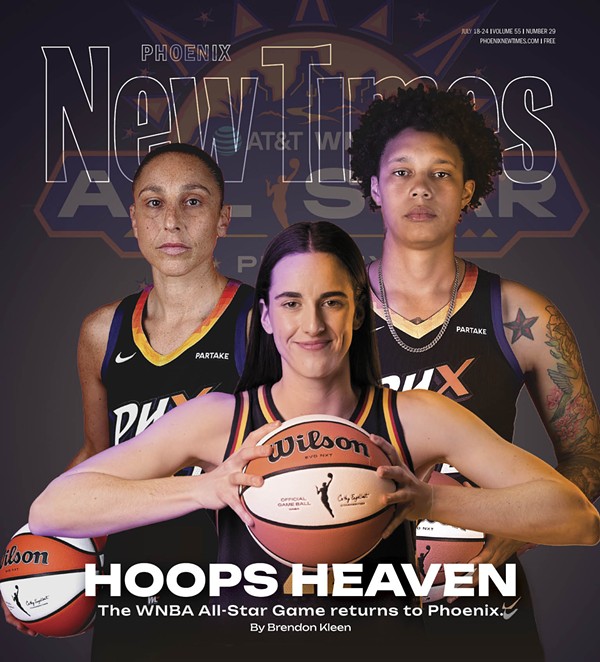The name quickly paints the picture: rubber chicken followed by broad bedroom farce. The snowbird audience members laugh dutifully through act one and spend act two nodding into their second complimentary daiquiri. If the name "Windmill" conveys any glamour at all, it's because actor Bob Crane, star of Hogan's Heroes, had been performing in the play Beginner's Luck there the night he was murdered in a Scottsdale apartment in 1978.
Fast-forward 19 years. The Windmill has been transmuted into Buzz ("the original funbar"), an upscale dance club and gin mill, decorated in a vague, not-too-rigorous jungle motif--native shields on the walls, leopard-skin tights on the waitresses. It's the type of place athletes go to get arrested.
The highlight of the evening at Buzz two Saturdays ago had theatrical and metaphysical ambitions. It was to be a midnight seance, an attempt to call back the spirit of Bob Crane.
Officiating was the Valley's answer to Kenny Kingston, psychic Jan Ross, who was hoping to get some definite dope on the still-mysterious Crane case. Crane's crony John Carpenter had been tried and acquitted for the gruesome murder in 1994. Ross asserts that the actor's uneasy spirit "has never left the building." She's mum on why his spirit doesn't hover instead at the apartment building where he was offed. But the spirit-Crane may have reason to prefer Buzz. All personal accounts of him suggest Crane would lean toward checking out the abundant pulchritude--scores of disco babes--partying at the venue formerly known as Windmill.
In any case, Crane's spiritual presence can't be because of fond memories of Beginner's Luck, the dismal, staggeringly unhip sex comedy he was starring in at the time of his death. The play, by Norman Barasch and Carroll Moore, was already pitifully dated when it premiered in 1970. How's this for dialogue?
Monica: . . . In case you're wondering,
I'm on the pill.
Paul: . . . Oh?
Monica: I guess most girls are
these days.
Paul: Yeah. Funny, just a few years
ago, it was the boys who were
sneaking into the drugstore.
It could almost make bludgeoning seem an attractive fate.
A high school dropout from Connecticut, Crane entered show business as a jazz drummer and went on to become a disc jockey and stage actor in Los Angeles. He broke into TV with spots on The Dick Van Dyke Show and Alfred Hitchcock Presents, and played Donna's neighbor on The Donna Reed Show.
The role of POW and smirky saboteur Colonel Robert Hogan on Hogan's Heroes, which debuted on CBS in 1965, gave Crane an instant stardom that faded almost as quickly when the show ended in 1971. His second sitcom vehicle, 1975's The Bob Crane Show, sank after three months on NBC. Then he spiraled through a series of guest shots on Love, American Style; Night Gallery; and The Love Boat, and he starred opposite the young Kurt Russell in Superdad, a miserable Disney feature. Nothing in his career would ever add up to the level of fame that he got from half-affectionately making fools of cartoon Nazis.
The police investigation showed Crane had long been an obsessive philanderer, with a special passion for videotaping his sexual exploits. After his murder, police became convinced that Carpenter, a video technician who had helped Crane with his hobby, had also done him in, although they never were able to produce hard evidence of that, or even to clarify a motive.
The DJ at Buzz on June 28 kept reminding the crowd on the packed dance floor that, at midnight, it'd be participating in the "World's Biggest Seance." The idea, apparently, was that at the witching hour, the dense, pulsating mass of well-heeled humanity would stop undulating to blaring synth-tech-pop and watch the show. On the stage, Jan Ross would summon Crane's ethereal essence and impart to the flock whatever information she might glean. Then her colleague, the nondenominational Reverend Roderic Vickers, would perform a prayer service in which the goodwill of all present would help Bob Crane pass on to the next level.
The lesson of the evening was that "big" and "seance" are concepts that don't go together well. Whatever metaphysical efficacy it may have had, the World's Biggest Seance was a bust as theater. There is one element absolutely essential to a properly atmospheric seance, and it's something you just can't get from several hundred beer-plied Scottsdale clubbers--quiet.
At midnight, the lights were lowered. I allowed somebody to light the small, white candle I'd been handed when I walked in. If, by this action and a few good thoughts, I could actually help a wayward spirit find peace, I certainly would not shirk.
But the thousand points of light around me, in proximity to all the alcohol breath and aerosoled hair, made me uneasy. I could picture the next day's headlines, "Dozens Die in Scottsdale Club Fire," slapped on news stories that surely would bring up "The Curse of Bob Crane." I started looking for the exits.
The music was turned off, but the crowd roared on in blind Saturday-night rowdiness. The DJ made a few polite attempts to shush them. They roared louder. Jan Ross stepped to the mike, looking like a fed-up high school typing teacher, and asked the crowd to quiet down. The roar waned and waxed like the sea in a tempest. Finally realizing it wasn't going to get any quieter, the DJ forged ahead. Over the din, he prompted the daunted Ross with leading questions.
By now deflated, Ross tersely answered him that she had already been in touch with Crane's spirit earlier in the evening. She said she had felt the pain of his bludgeoning in the back of her head (she was probably feeling it again right about now). It was hard to hear every detail over the roar, but it sounded like she said that the killer was a man with dark hair and dark eyes. He was a good friend of Bob Crane's, she said. The good friend had thrown the blunt instrument he had used to brain his buddy into a canal.
Ross made her escape by inviting the Reverend Roderic, a pleasant-looking man in impressive, white-and-green clerical garb, up onto the stage. In a dulcet English accent, the reverend blessed the crowd, and exhorted us to "think about Bob Crane!"
I did my best. Surveying the scene, something told me that if Bob Crane was watching, he must be having his first good laugh since he died.
Amazingly, the sight of the Reverend Roderic made the roar subside a bit. But the rev didn't push his luck. He was a trouper; he knew how to adapt as best he could to a tough crowd. "All the noise you want to make now, I'm sure, would be very helpful!" he said. The crowd howled happily, exultantly, louder than ever. "God bless you all," said the Reverend Roderic beatifically, and he and Jan Ross got off the stage while the getting was good.
Later, outside the club, the Reverend Roderic sweetly assured me that the Buzz revelers were helpful to Crane's spirit. "These were the sort of people he liked; this was the sort of fun he liked."
Buzz isn't through with Crane yet. On July 11 and 12, the club is celebrating his birthday. Ad fliers for the "1st annual" Bob Crane Birthday Bash promise that "Buzz will be transformed into Stalag 13" for these festivities.
On the surface, this Cranemania is a little puzzling. It's understandable enough that Buzz would try to publicize itself through its connection with Crane--why not?--but it's bizarre that this marketing strategy would prove so viable. Several TV stations were there for the seance, and other print media, too.
And this isn't even the nice, even-numbered 20th anniversary of the grim event--it's the 19th. Who celebrates the 19th anniversary of anything? Did Elvis get this kind of treatment on the 19th anniversary of his alleged death? Why do we care about Bob Crane, a minor star who happened to die here?
And yet, it makes sense that Crane's untimely, news-making death remains a watershed in Valley memory. The Valley has, in its way, a show-biz scene, but it's a transient one. Road shows play here, then leave. Movie companies shoot here, then leave. Nick Nolte trod the boards of Phoenix Little Theatre as a kid, then he left. At 17, Steven Spielberg used the PLT space to show his home movie Firelight. Then he left.
Crane came to Scottsdale, did a bad play, fooled around a little. But he didn't just get to split for the next hick town--if you believe Jan Ross, he still hasn't left. The death of Bob Crane was the revenge of the whistle stop.
Nobody expects to find a rich and distinguished theater history in a city as new as Phoenix. Theater lovers in the Valley might wish that the most notable event in our theater history was something less ignominious, less sordidly kitschy, than the murder of an oversexed, has-been TV star on the dinner-show grind. We could wish better for poor Crane's ghost, and for ourselves, too.
Just go to the light, Bob.










